HTWWW's "World Preview" at the Empire Cinerama Theatre in Paris |
Read more at in70mm.com The 70mm Newsletter |
| Written by: Gerhard Witte, Berlin, Germany | Date: 03.05.2015 |
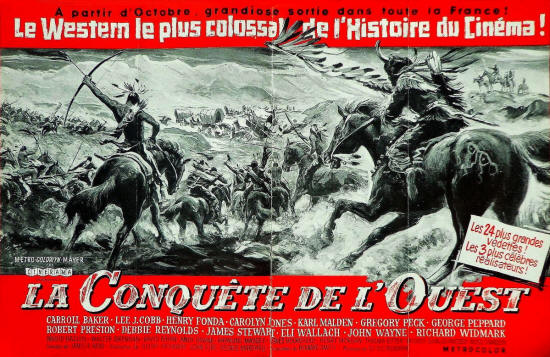 Autumn
1963 advertisment for the general 35mm CinemaScope release in La
Cinématographie Fançaise/Le Film Français. Autumn
1963 advertisment for the general 35mm CinemaScope release in La
Cinématographie Fançaise/Le Film Français. Click the image to see enlargement The Cinerama movie "How the West Was Won" (USA) had its official World Premiere on Thursday, November 01, 1962 at London's Casino Cinerama Theatre, where it subsequently successfully ran for more than 120 weeks. Previously, there had already been a "World Preview" of the movie at the Empire Cinerama Theatre in Paris on Tuesday, October 02, 1962. An extract taken from an article written in the German trade magazine "Film-Echo/Filmwoche" dated October, 1962: On 2nd October, the festive "World Preview" of the Cinerama feature film (no travelogue) "How the West Was Won" was held at the Empire Cinerama Theatre in Paris. The MGM Cinerama production cost more than 60 Million D-Mark. On this occasion, the President of Cinerama, Inc., New York, Nicolas Reisini, and MGM's President, Joseph R. Vogel, invited over 1000 theatre owners, journalists, radio and television people and public representatives from a lot of countries to Paris. Wolfdieter Freiherr von Stein, Director General of "Deutsche Cinerama GmbH", invited to the event following German theatre owners: Dr. Schoofs (Köln/Essen), R. Billerbeck (Hannover/Bremen), W. Jonigkeit (Berlin/Hamburg), O.P. Freiberger (Hamburg), M. Bertuch (München/Berlin), R. Englberth (München), K. Krüger (Düsseldorf), M. Goldermann (Düsseldorf), S. Lubliner (Frankfurt), F. Colm (Stuttgart), and K. Pflughaupt (UFA Düsseldorf). After the impressive premiere there was a midnight reception in a Parisian restaurant which had been converted into a western saloon. |
More in 70mm reading: How The West Was Won Empire, Paris The Cinerama Presentations Cinemiracle/Cinerama in Germany |
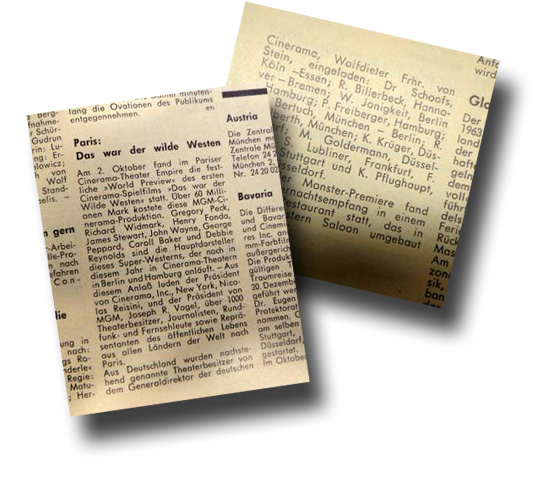 A short article about the "World Preview"
written in the trade magazine "Filmblätter" (No.42) dated October 13,
1962: A short article about the "World Preview"
written in the trade magazine "Filmblätter" (No.42) dated October 13,
1962: "Wild West" in Paris The crowd of Parisian celebrities taking the escalator into the Empire Cinerama Theatre, capable of accommodating in excess of a thousand people, spanned from Michele Morgan to Juliette Greco. They had been invited to Paris by Nicolas Reisini, President of the affluent Cinerama company, who not only speaks five languages, but also knows all the ins and outs of "Public Relations", to show them in the European capital city an American movie: "How the West Was Won". Why did Mr. Reisini do such a thing? Was he afraid of American criticism? He said, "It is nothing special to show a Western in the USA, but in Europe one can only dare to do so if one has more than a Western to offer". And more information here: "New York VARIETY" dated Wednesday, October 10, 1962. "West Was Won" Given Wild West Sendoff in Paris – Cinerama Lauded. Big gala nights are being handed Paris first-nighters these days by Yank producers. After the premiere and party for "The Longest Day" (20th Fox) on September 25, a private premiere Tuesday (2) night of the Metro-Cinerama coproduction "How the West Was Won" at the L´Empire-Abel Gance, was followed by a giant party in true old west style. Exhibitors from all over Europe plus Cinerama and Metro Continental representatives, and a task force from the U.S. headed by Cinerama president Nicholas Reisini and "West" producer Bernhard Smith, and a batch of Continental Press people, crammed the theatre for a premiere of the better than two-hour epic, without subtitles. Though estimated that only 10% to 15% of the audience had a good English flair, the film won applause throughout for its visual beauty and derring-do as well as its stars. Then a party was put on in the Cinerama Restaurant in the confines of a big room which is to retain its Wild West decor as a sort of oater Disneyland for kids and adults. Saloons, old banks and landscapes dotted the room with a series of stages that housed many bands, acts and well-rehearsed knockabout fights plus a striptease. The latter was for one night only. Festivities went on till dawn. A short consensus showed that visitors felt the storytelling potentialities of the Cinerama process had reached a peak, and also that those dividing lines on the three panel screens were just about invisible. Also present was a VIP group from United Artists which will utilize Cinerama on two forthcoming pictures. The actual "West" world premiere is at the Casino Theatre, London on November 01. The film press and trade people at the "West" premiere also were joined by Culture Minister Andre Malraux. A bevy of stars and French names from all walks of show biz and diplomatic channels. |
|
François CARRIN, France has added this: |
|
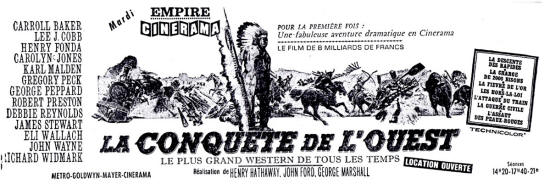 Tuesday,
November 27, 1962 - The 1st day public screening Tuesday,
November 27, 1962 - The 1st day public screeningClick the advert to see an enlargement |
|
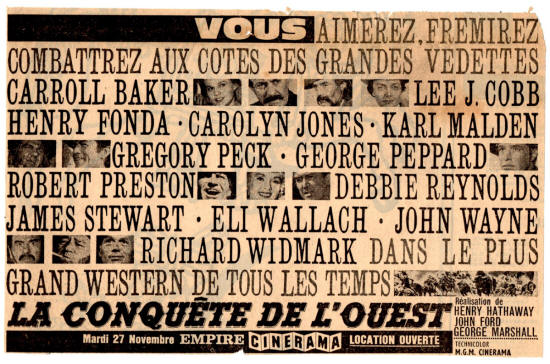 Probably
one week before the release. Probably
one week before the release.Click the advert to see an enlargement |
|
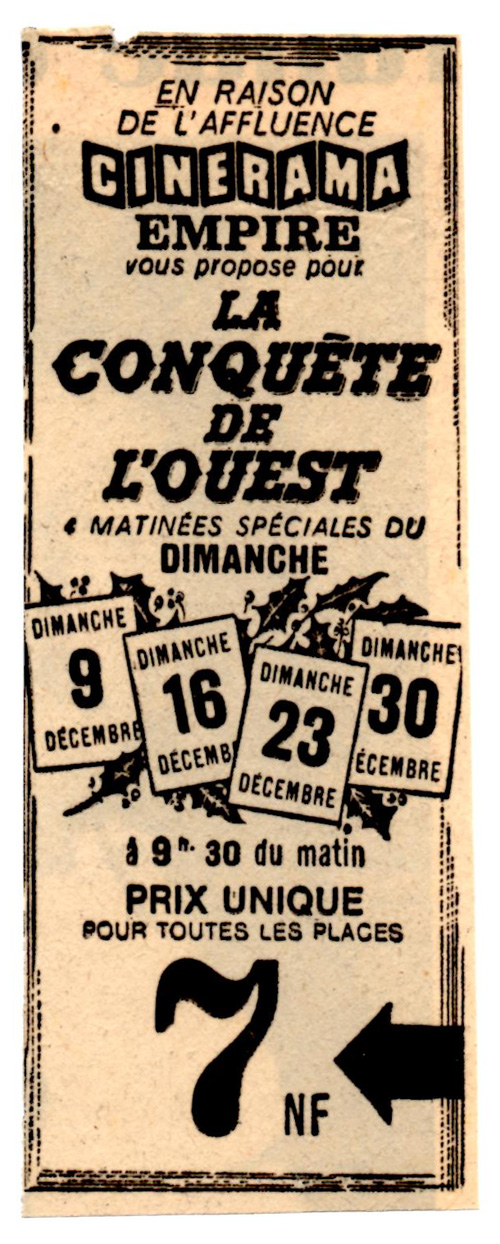 As
the film was very successful they organized matinees Sunday morning during
December 1962 with an unique rate of 7 New Francs( +/- 1 US $)* and a
special screening at 0:30 for New Year's Eve. They tried again some years
later with other films but performances were cancelled as audience was
missing ! As
the film was very successful they organized matinees Sunday morning during
December 1962 with an unique rate of 7 New Francs( +/- 1 US $)* and a
special screening at 0:30 for New Year's Eve. They tried again some years
later with other films but performances were cancelled as audience was
missing !* In 1962 EMPIRE CINERAMA was the most expensive cinema in France ! |
|
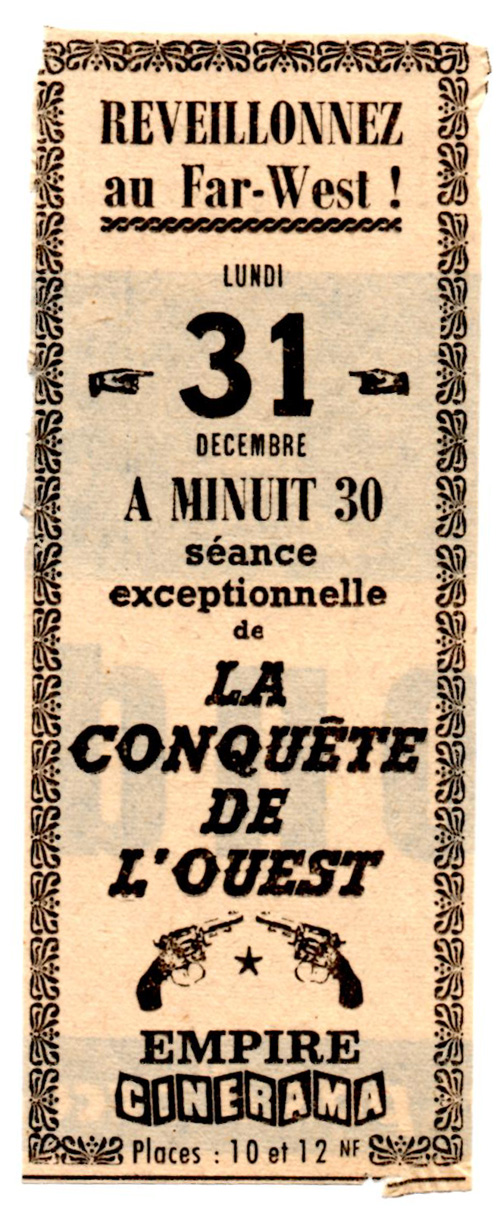 |
|
German Premiere |
|
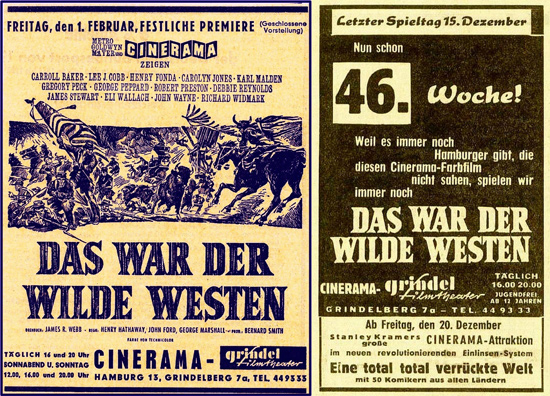 "Because there are still Hamburg citizens, who did not see this Cinerama
film, we are still playing "How the West Was Won". "Because there are still Hamburg citizens, who did not see this Cinerama
film, we are still playing "How the West Was Won". The festive German Gala Premiere of the movie took place at Hamburg's Cinerama "Grindel Filmtheater" on Friday, February 01, 1963 (see premiere advert on the left side), where it subsequently successfully ran for 45 weeks and 2 days, until Sunday, December 15,1963. The following film was "It’s a Mad, Mad, Mad, Mad World" (USA, 1963) which premiered on Friday, December 20, 1963. It was shown in the new single lens 70mm Cinerama process (announced in the ad from 12.12.1963 on the right side). For the change from 3-strip Cinerama into 70mm Cinerama and other things, the cinema had been closed for 4 days at the time. The "Grindel-Filmtheater" was demolished in April 2009. Here some information about this cinema treasure: The Grindel Filmtheater Das Grindel Filmtheater |
|
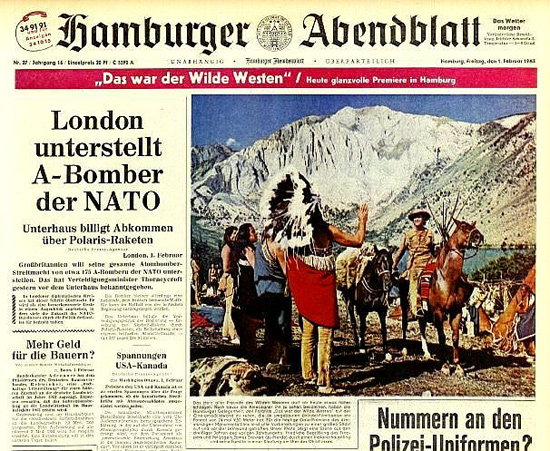 The "Hamburger Abendblatt" newspaper greatly announced the movie's
premiere on its front page in full colour on Friday, February 01, 1963:
"How the West Was Won" – today glittering Premiere in Hamburg." The "Hamburger Abendblatt" newspaper greatly announced the movie's
premiere on its front page in full colour on Friday, February 01, 1963:
"How the West Was Won" – today glittering Premiere in Hamburg."
The image caption reads as follows: From today, the hearts of all the friends of the Wild West may beat a little faster. Even before the Americans can watch it, Hamburg citizens have the opportunity to enjoy the colour movie "How the West Was Won" on the Cinerama screen, which has in the converted "Grindel-Filmtheater" a size of 24 x 9,50 metres. Authors's comment: That must be the size measured straight across the curve from side to side. Along the curve was given a size of 27 x 10 metres – also the Cinerama "Europa-Palast" in Essen had at the time a screen of this size. Both screens were, of course, louvered screens. For today's Gala Premiere of the monumental three-hour movie all preparations have been done for a big show on and in front of the screen. Our photo shows a scene from the thirties of the last century: A peaceful welcome of the fur trapper James Stewart (on horse) by a sachem and his family in a settlement on the banks of the Ohio River. |
|
|
A review from the time of the movie´s London World Premiere:
"New York VARIETY" dated Wednesday, November 07, 1962 written by Myro. Reviewed at Casino Theatre, London, Nov. 01, 1962 – Running time, 155 minutes. "How the West Was Won" (Cinerama-Technicolor) In three words: A boffo blockbuster. (Author´s comment: "boffo" is an informal term meaning: highly successful, a hit show) There can be no element of doubt about "How the West Was Won". This, the first story-line film in Cinerama to reach Europe, is the blockbuster supreme, a magnificent and exiting spectacle which must, inevitably, dwarf the earnings of the travelogues in the three-screen process. It will, undoubtedly, run for several years, and will become one of the industry's all-time top grossers. Backed by a substantial campaign, the spectacular opened in London with an advance of almost $450,000, including an unprecedented ticket brokers` guarantee of $280,000 for the first year of the run. That's indicative of the success to come, and Metro and Cinerama, who are 50-50 partners in production, should be reaping lush returns. Technically, there is a vast improvement in the process. The print joins are barely noticeable, and the wobble, which beset earlier productions, has been eliminated. And that enhances the entertainment immeasurably, for the customer can concentrate on the breathtaking backgrounds and action without any distraction. It would be hard to imagine a subject which lends itself more strikingly to the wide-screen process than this yarn of the pioneers who opened the American West. It's a story which naturally puts the spotlight on action and adventure, and the three directors between them have turned in some memorable sequences. George Marshall, for example, has the credit for the buffalo stampede, started by the Indians when the railroad was moving out West. This magnificently directed sequence is as vivid as anything ever put on celluloid, and has the excitement to compel an audience to sit bolt upright in their seats. Undoubtedly, the highlight of Henry Hathaway's contribution is the chase of outlaws who attempt to hold up a train with a load of bullion. This item must, inevitably, be regarded as the latter day widescreen "Great Train Robbery". The scene packs more excitement and dramatic punch in a few minutes than many motion pictures in two hours. John Ford´s directional stint is limited to the Civil War sequences, and though that part does not contain such standout incident, there is the fullest evidence of his high professional standards. |
|
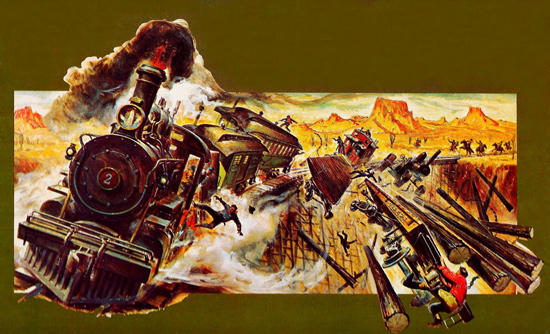 Henry Hathaway's magnificent train sequence "The Outlaws" – "The climax
is the greatest train wreck ever filmed. At the end of it you could hear
the escape of held-breath all over the cinema" from "The London Evening
News". Image taken from the gatefold cover of the movie's soundtrack LP
MGM 1SE5. (Poster artwork by the American artist Reynold Brown) Henry Hathaway's magnificent train sequence "The Outlaws" – "The climax
is the greatest train wreck ever filmed. At the end of it you could hear
the escape of held-breath all over the cinema" from "The London Evening
News". Image taken from the gatefold cover of the movie's soundtrack LP
MGM 1SE5. (Poster artwork by the American artist Reynold Brown) The story is far and away at its best when the emphasis is on the action, but the more intimate moments of the plot come out surprisingly well on the big screen. As the cast list indicates, more than a dozen front ranking international stars, together with top supporting names, are used to tell the story, and though the majority have smallish roles, their appearances on screen serve a two-fold purpose. Having familiar names around eases character identification in such a vast subject; and additionally, of course, they are invaluable as extra box office bait. The story-line is developed around the Prescott family, as they start on their adventurous journey out West. Karl Malden and Agnes Moorehead are the parents, and with them are their two daughters, played by Debbie Reynolds and Carroll Baker. They start their journey out West down the Erie Canal, and when James Stewart, a fur trapper, comes on the scene, it's love at first sight for Miss Baker. Although they are headed in opposite directions, she eventually gets her man. After her parents lose their lives when their raft capsizes in the rapids – and that's another of the highly vivid sequences directed by Hathaway – Miss Reynolds joins a wagon train to continue her journey and tries, in vain, to resist the charms of Gregory Peck, a professional gambler, who is first attracted to her when she's believed to have inherited a gold mine. They are the principal people in the "intimate" part of the story, and Miss Reynolds is about the only lasting the whole length of the picture. Her performance is a surprise even for her most devout fans. There is an unexpected quality to her acting and a wider emotional sweep than usual. She ages with delicate grace, and towards the end, when her possessions are being sold by auction, she looks back philosophically on a happy and contented life. As always, Peck gives a suave and polished gloss to his role of the gambler, and though it´s an undemanding part he gives it notable distinction. Stewart has some fine, if typical, moments in his scenes, and he gets involved in a magnificently directed fight with some unprincipled adventures who try to rob him and his friends of their possessions. It´s a no-holds barred punch-up in which anything goes. |
|
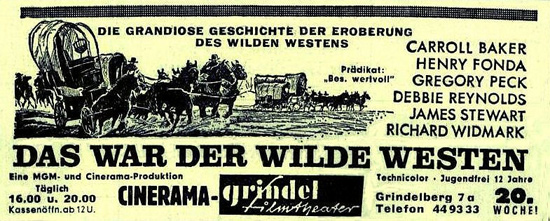 "The grandiose Story of the Conquest of the Wild West" – "Grindel"
advert from 13.06.1963. The film's story, woven around the individual
fate of a pioneer family over several generations, covers the period
from 1839 to 1889. After eleven months of filming three of the most
famous American directors had completed the five episodes: The River,
the Plains, the Civil War, the Railroad, the Outlaws. Much of the
location footage was shot by the Cinerama camera in national parks and
national forests from South Dakota to California. The movie was rated
"of special merit" by the German Movie Rating Board. "The grandiose Story of the Conquest of the Wild West" – "Grindel"
advert from 13.06.1963. The film's story, woven around the individual
fate of a pioneer family over several generations, covers the period
from 1839 to 1889. After eleven months of filming three of the most
famous American directors had completed the five episodes: The River,
the Plains, the Civil War, the Railroad, the Outlaws. Much of the
location footage was shot by the Cinerama camera in national parks and
national forests from South Dakota to California. The movie was rated
"of special merit" by the German Movie Rating Board. Richard Widmark makes a vital impression as the head man of the construction team building the railroad. He is tough and uncompromising, and it´s his determination to press on disregarding the human suffering he may cause, that leads to a clash with the Indians, and the previously mentioned buffalo stampede. John Wayne is another top ranking star with only a minor part as General Sherman in the Civil War episode, but he, too, makes the character stand out. Another superb cameo comes from Eli Wallach, as the bandit who leads the gang in the train robbery, while Robert Preston plays the wagon master with great authority and sincerity. There is another excellent portrayal from Henry Fonda, who is the white man´s emissary to the Indians, and he invests the part with considerable dignity. Other distinctive contributions come from Lee J. Cobb, Carolyn Jones, Karl Malden and George Peppard, and all the feature players. The courage and tenacity of the pioneers is effectively etched in James Webb´s screenplay, but the narrative is no more than a peg for the magnificent action sequences, which dominate the production. The story is never intended to be more than a slender thread. That´s surely the right approach, and is underlined by Bernard Smith´s monumental production. The technical credits cannot be faulted, and the four cameramen contribute some of the best ever lensing seen in motion pictures. The music in another pleasing feature - and the trio of art directors has designed some impressive sets. Spencer Tracy is heard but not seen as the narrator. In a clear, well-spoken commentary he provides the introduction to the story, and also the closing comments. And the final scene, of the present day West, with its crowed highways, is a striking salute to the adventurous pioneers. |
|
| Go: back - top - back issues - news index Updated 22-01-25 |
